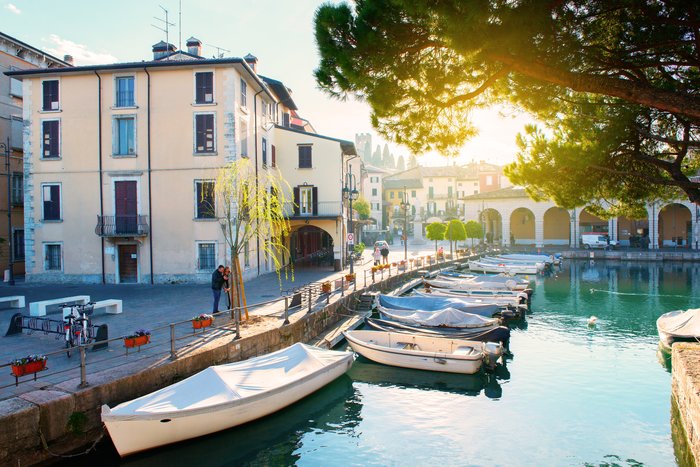Drive to Lake Bolsena, Orvieto, & Viterbo, Orvieto
Overview
Visit Orvieto, a small hilltop town populated since the Etruscan times. Then, swap cobblestones for scenic nature at Lake Bolsena and enjoy a leisurely walk or break. Next, make a detour to discover Italy’s hidden gem of Pitigliano, and finally visit Viterbo, a city with important history, beautiful churches, fountains, and stairs.
Suggested Activities:
1. Orvieto is impressively situated high upon Tufo rocks and is famous for white wine and gelato! It has one of the most beautiful cathedrals in Italy and acts as a labyrinth of small alleyways with shops and restaurants.
- Climb aboard the cable car and enjoy the view as you ride this funicular through a tunnel of trees and arrive at a fortress. You'll arrive in Piazza Cahen near St. Patrick’s Well and the Ruins of the Etruscan Temple of Belvedere.
- Visit the main cathedral, Duomo di Orvieto. Towering over the medieval square, this impressive building looms over passersby.
- Climb Torre del Moro for the best views of the city. Established in the late 1200s to defend the town, this historic tower now provides a beautiful, unobstructed panorama of the town's medieval streets, the Duomo di Orvieto, and the hills beyond. Take the small elevator, then climb the 236 steps to the top to reward yourself!
- Explore the Etruscan Orvieto Underground that has 440 caves, of which some are open to the public. In addition, the tourist office organizes guided tours in the Parco delle Grotte. These caves were once water reservoirs, stone pits, wine caves, and even hiding spaces during World War II. It's chilly inside, so don't forget a jacket!
- Climb down to the bottom of St. Patrick’s Well. Climb the 496 steps down to the bottom and take in the shocking size of this well! Forty-five feet wide and an impressive 175 feet deep, locals used it in the 16th century as a place of refuge for the pope. You can see why the phrase “it’s like digging St. Patrick’s Well” is commonly muttered by Italians when asked to complete a challenging task.
- Enjoy wine tastings or tours at Cantina Custodi or Cantine Neri.
- Explore the artisan shops known for their ceramics. Be sure to check out these local ceramic shops: La Corte dei Miracoli, Ceramiche Fusari, Ceramiche Bellocci. For leather and shoes: Federico Badia.
3. Pitigliano is a breathtaking town carved into the Tufo rock. In the heart of the Tuscan Maremma, Pitigliano is one of the most beautiful villages in Italy. Also known as "Little Jerusalem," the town hosted a large Jewish community within its walls in the 16th century.
4. Viterbo has the largest medieval historical center in Europe.
-
Visit the churches of Viterbo. The town's 13-century Cathedral is where the eight popes elected in Viterbo are crowned and where Corradino di Svevia, heir of Frederick II, was excommunicated. The church and monastery of Santa Rosa are where the "Machine of Santa Rosa" starts, a procession held in early September where locals carry a canopy and a statue of the saint around the city. The small Church of San Silvestro, built before 1000 CE, is also worth visiting, as is the Church of Santa Maria Nuova.
- Among the palaces of Viterbo, the most famous is certainly the Palazzo dei Papi, built in the mid-1200s and decorated with a beautiful loggia called "of the blessings" because the popes looked out from here to bless the people. Palazzo dei Priori is famous for the 16th-century Sala Regia and its beautiful frescoes.
- You can access the San Pellegrino District from Piazza San Carluccio. To the right of the fountain of San Carluccio, you'll find the Via di San Pellegrino, which is the main road axis of the medieval quarter. Characteristics of the neighborhood are the profferli, external staircases that lead to the landing of the houses, and the so-called "bridge house," a type of house that unites two buildings through hidden passages.
- Visit the Palazzo degli Alessandri, established in the first half of the 13th century, which overlooks the square of San Pellegrino and the 11th-century Church of S. Pellegrino. A walk in the neighborhood will help you grasp the true essence of the ancient village.
Read more about unique and interesting cultural experiences in Italy.
Like what you see?
Chat with our local specialists and let us help you customize your trip with experiences like this.
Get startedLike what you see?
Chat with our local specialists and let us help you customize your trip with experiences like this.
Get startedItaly Experiences
Show more Italy experiences
Explore Local Beaches
The beaches along Sorrento’s southern coast are some of the most beautiful in Italy. As a result, many people choose to spend all or part of their trip on this small stretch of...

Early Morning Vatican Tour in Rome
Discover the museums of the Vatican City and the Sistine Chapel with an early-morning tour of the city's incredible art and history. By visiting the Vatican Museums early,...

Lake Garda with Kids & Teens
Lake Garda is the most family-friendly Italian lake. There are many activities to enjoy in amazing nature and a significant number of theme and water parks for everyone but...

Dog Sledding Excursion
Learn to mush a team of sled dogs on the slopes of the Julian Alps in Tarvisio, just over the Slovenia-Italy border, with the help of an experienced musher. After a briefing on...

Hiking the Path of Gods on the Amalfi Coast
Hike one of the most beautiful trails in Italy, the “Path of the Gods” on the Amalfi Coast. Enjoy the incredible panoramic views as you walk about 1,600 feet (500 m) above sea...
Best of Umbria
Best of Umbria
Ultimate Guide to Umbria: Hill Towns, Art, and Culinary Treasures
Often overshadowed by Tuscany, its culturally mega-rich neighbor, Umbria is brimming with treasures of its own. Think gorgeous medieval hill-towns, plenty of art, and...

Self-Drive Italy: Hill Towns of Tuscany & Umbria - 8 Days
The medieval hill towns of Tuscany and Umbria take center stage on this relaxed, 8-day road trip through the Italian countryside. Starting in the ancient city-state of Cortona,...


Undiscovered Central Italy: Le Marche, San Marino & Umbria Road Trip - 8 Days
Step off the beaten path and discover some of central Italy's hidden treasures on this relaxed eight-day road trip. Start in the bucolic region of Le Marche, where the medieval...


Undiscovered Central Italy: Marche & Umbria - 6 Days
Skip the crowds on this packed 6-day jaunt through Italy’s lesser-known central regions. Hidden between the Apennine Mountains and the Adriatic Sea, Marche boasts the rolling...


Undiscovered Central Italy: Marche, San Marino & Umbria - 9 Days
This leisurely 9-day itinerary introduces you to the medieval hill towns and rolling countryside of Italy's lesser-known central regions. Skip the crowds and explore the...
Trip Planning Essentials

How kimkim Trips Work in Italy
Italy is one of the most sought after destinations in the world for its history, romance, and (of course) incredible cuisine. Hit the classic stops or head off the beaten...

Ultimate Italy Itineraries: 5, 7, 10 & 14 Days
A trip to Italy should be well researched and painstakingly planned out: that's why we've done that part for you! Our local specialists and travelers told us what they love most...

Italy Travel Agents
Kimkim has selected the best Italy travel agents so you'll have a worry-free trip




